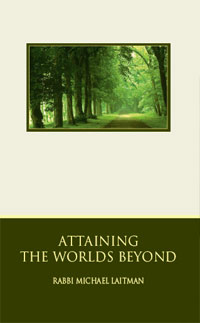The Search for the Middle Line
Trying to reject, correct the inherently egocentric human nature, or to find ways of using it an optimal way can be found at the rit of many faith systems, spiritual methods.
The principle of rejecting self-gratification, which was adopted by one of the world’s major religions, and the principle of attaining pleasure, which was chosen by another, both stem from the impure (egoistic) forces (Klipot) of the right and the left lines of the spiritual ascent. Thus, where Kabbalah discusses the subject of placing limitations on oneself, it implies a preliminary stage of working on the self: making an attempt to reject the idea of self-gratification using one’s own willpower.
The roots of all different types of faith, of all spiritual tendencies, of all groups, and of all religious philosophies can be traced to the various klipot. These surround the left and the right spiritual pure lines, which are sustained through the process of seizing-grasping (Ahiza) or through drawing nourishment (Venika).
But the goal of any task is to attain the middle line, to rise to the infinite that has no end or boundary, thus attaining the perception of the Creator, unlimited by particular human qualities.
The Gradual Appearance of the Creator
In spiritual vocabulary, a desire is regarded as a “place.” The absence of desire is considered to be “the absence of a place.” This is similar to a situation when a person declares that no place exists in the stomach for food, since there is no more desire to eat.
A spiritual place, or the desire of an individual to perceive the Creator, is known as “the vessel” (Kli) of the soul, or Shechina. This vessel receives the Light of the Creator or the Revelation of the Creator, also known as “the soul” of the person. The Creator Himself is known as the Shochen.
Since all our desires are permeated with our egoism (desire to receive), the Light of the Creator is concealed. As egoism is gradually ejected from our desires, a greater place becomes available. An uncorrected desire is known as “egoism.” A corrected desire is called “Israel.”
Once a “place” is vacated as a result of a corrected desire, the Light of the Creator is revealed, but the Creator still continues to operate in a manner concealed from us. After we have corrected and purified our desires (places, vessels), we perceive the process of the Revelation of the Creator as the appearance of the Light. In reality, however, no motion takes place, but rather, as in the process of developing a negative, the Light gradually appears in our perception.
The Redemption of the Shechina (Creator)
Since we do not perceive the Light itself, but only its effect on our vessel, we address the Creator by the name associated with His Revelation: Shechina. However, we can only determine His Essence by the sensations and feelings that He invokes in us. For this reason, the Revelation of the Creator is known as Shechina.
If the Creator conceals Himself, then it said that “the Shechina is in exile”; or that “the Creator is hidden.” But if an individual has earned the Revelation of the Creator, then it is known as “the return from the exile.”
The Correct Desires Reveal the Creator
The varying degree to which the Creator reveals Himself to us is called “the soul” (Neshama).
As soon as we are able to correct at least one of our desires into an altruistic one, we receive an immediate perception of the Creator.
Thus, it is said that the human soul is part of the Creator.
Once we reach the final stage of correction, the Creator will fill all our desires, that is, He will reveal Himself to the ultimate degree to which He planned to reveal Himself in His creations. All our desires were designed for this ultimate purpose at the very beginning of creation.
 “The Correct Desires to Perceive Spirituality” is based on the book, Attaining the Worlds Beyond by Dr. Michael Laitman.
“The Correct Desires to Perceive Spirituality” is based on the book, Attaining the Worlds Beyond by Dr. Michael Laitman.

